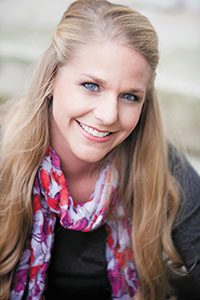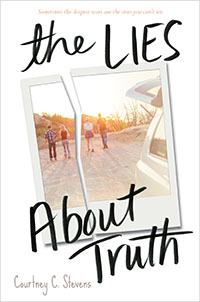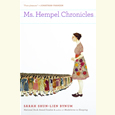Writing in the Direction of Brokenness
Courtney C. Stevens talks with Chapter 16 about her new novel for young adults, The Lies About Truth
Is there such a thing as a good lie? Courtney C. Stevens explores this question in her new young-adult novel, The Lies About Truth. Stevens’s second book is a tender portrayal of pain, a portrait of loss, and a study of the many faces of grief. A group of teens, centered on seventeen-year-old Sadie Kingston, must figure out life post-trauma. Full of heart and heartache, the novel will touch any teen dealing with loss—or even simply a changing social dynamic.
 Stevens recently answered questions from Chapter 16 via email.
Stevens recently answered questions from Chapter 16 via email.
Chapter 16: You’ve said in the past that you are an “aftermath writer,” that your specialty is stories that show characters who are dealing with the aftermath of an event, rather than surviving the event itself. Why that focus? How is it reflected in The Lies About Truth?
Courtney C. Stevens: So many people walk wounded through life, wondering what to do with the pieces of unfair events they’ve experienced and choices they regret. I know. Because, at times, I am one of those walking wounded. I write in the direction of my own brokenness and hope that others might learn on my dime. In The Lies About Truth, Sadie, the main character, experiences two types of brokenness: physical and relational. Therefore she’s traveling through the emotions of impasse and forgiveness. I believe feeling stuck and blaming others are two things that readers might relate to as they read.
Chapter 16: You’ve said that you moved to Nashville for its writing community. Can you describe the benefits of a writing community, and specifically what Nashville’s has to offer?
Stevens: Nashville musician Andrew Peterson has a song called “Nashville.” He sings, “Oh, I love this city. Everybody’s got a song.” It sounds crazy to say that I moved here for the music and story and dreams that float through the air of Middle Tennessee, but I did. If you live here, you know what I mean. Possibility will whip your hair like a river wind, and it’s magic to have community (and hope) in a tough industry.
My critique group lived here first. They introduced me to the Nashville community of writers. When my life in Bowling Green, Kentucky, began to shift, I put my stuff in a truck and moved to where they were. Immersing myself in their friendship and wisdom has enhanced my life and writing in powerful ways. I now seek to do the same for other writers/artists. As far as what Nashville has to offer for authors and illustrators: vibrant chapters of the Society of Children’s Book Writers and Illustrators and Music City Romance Writers, Parnassus Books, East Side Story, Humanities Tennessee, the Southern Festival of Books, the Southeaster Young Adult Book Festival, Killer Nashville, Salon@615 events, the Nashville Public Library, and the Porch Writers’ Collective, just to name a few. [See Chapter 16’s Resources for Tennessee Writers page, here, for details about each.]
 Chapter 16: You were a youth minister prior to (and while!) writing books for a young-adult audience. What about that career prepared you for this one?
Chapter 16: You were a youth minister prior to (and while!) writing books for a young-adult audience. What about that career prepared you for this one?
Stevens: For me: Youth ministry is about loving students. Writing young-adult fiction is about loving students. Everything about youth ministry prepared me for writing young-adult fiction, but more than anything it taught me to listen first, validate second, and love always. Our students are hungry for adults who listen earnestly and believe in their abilities to change the world. I hope I communicate that through the books I write and the opportunities I have to interact face-to-face.
Chapter 16: When the reader meets the main character, Sadie Kingston, she is, as you said recently at the Southern Festival of Books, stuck. Is it difficult to write a character like that? How did you accomplish writing a character who is stuck and yet interesting for the reader?
Stevens: In fiction, authors must walk a careful line between pity and sympathy. I want the reader to sympathize with Sadie, but even when/if she breaks their hearts, I don’t want them to pity her. She’s a tough girl. She’s been through the window of a Yaris and lived to tell about it. She’s lost her best friends, and she’s still upright. She has scars, and she’s figuring out those scars don’t define her.
I wrote the narrative of her being unstuck—her moving pathway toward healing. To aid the process, I used a study on impasse by Timothy Butler (author of Getting Unstuck) and applied the six stages of conquering impasse to the plot. That gave the narrative emotional movement and allows the reader to witness Sadie’s efforts to transform rather than her inaction.
Chapter 16: You’ve developed an app to accompany this book that simulates the “secret-keeper,” a stuffed ostrich named Big, in the story. Can you tell us more about that?
Stevens: One of my favorite subplots in The Lies About Truth is a stuffed blue ostrich named Big. After discovering a hole in her beloved arcade toy, Sadie removes the plush stuffing and fills him with little scraps of truths, secrets, and thoughts. Big acts as a confessional for Sadie. Admitting something—good, bad, terrible, perfect—is a powerful tool to emotional growth. Therefore, I built a free app, a virtual Big, so readers can have the opportunity to confess/admit truths that might help them move forward as well.
The app is called Big T (which stands for Big Truth) and is available in the iTunes store and on Android Market. It is meant to be Snapchat meets PostSecret, a place of anonymous confessions. What you write down is never read and is automatically deleted, but hopefully the act of writing truth—of telling someone—helps people.
Chapter 16: Your secondary characters—Gray, Gina, and Max in The Lies About Truth, and Bodee in Faking Normal—feel like so much more than second place. What do you see as the role of secondary characters in fiction?
Stevens: Secondary characters are the opponents and allies of the main character. They aid and complicate the journey between who a character is and who they will become by the end of the book. I build each secondary character specifically to add tension and relief for the main character. I want each person in the story to have flesh and bones and feel three-dimensional.
Chapter 16: So. What are the lies about truth?
Stevens: Well, I’d tell you, but it would be a lie. Hopefully people will read the book and decide for themselves.

Kristin O’Donnell Tubb is the author of The 13th Sign, Selling Hope, and (coming soon) John Lincoln Clem: Civil War Drummer Boy (February 2016) and Miss Daisy’s Job (summer 2017). Tubb lives in Williamson County.





